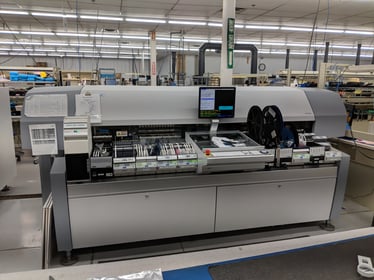
Anyone working in the electronic manufacturing industry needs to account for sufficient scrap factor when preparing for production of a printed circuit board assembly (PCBA).
So, what is scrap factor and why is everyone so worried about it?
Why should I care?
“There is always a certain amount of loss in any automation process and that’s what we are really talking about, that loss,” said RBB Equipment Engineer Dave Thomas.
Thomas has been a member of the RBB team for 36 years and is no stranger to scrap factor. In his current role, he maintains all equipment at RBB and makes sure everything is working properly.
“Whether you are setting up or tearing down, for RBB it is reels of small components, there is a certain amount of loss when you are setting the {SMT} machine up and during the carrying process,” added Thomas when explaining scrap factor. “It may mis-pick something or a vision system might not like what it sees, so it will throw it away.”
How can being familiar with scrap factor help you save production costs? Allowing for scrap factor will prevent additional costs for:
- Labor – hand-placing requires added labor
- Time -- machines can place components faster and at a higher frequency than a human
- Money – time and labor both cause an increase in price
- Material – purchasing extra materials will not be necessary
Scrap factor could be mistaken for lost or damaged components. This can give the word “scrap” a negative connotation. It is important to note that scrap factor is not due to the mishandling of the product, but the excess materials are required to account for any of the lost materials that are a result of the automation process. This could be also defined as insurance parts.
Thomas points out that some material is lost during production because of the nature of the high-speed machine, i.e. the SMT pick-and-place machine or the thru-hole auto insert machine.
 “There is a certain amount of loss from mis-insertion, even setting up and prepping equipment you are bending resistors or capacitors,” Thomas explained. “It is those kinds of things that are a smaller scrap factor, but you can lose a couple through that process.”
“There is a certain amount of loss from mis-insertion, even setting up and prepping equipment you are bending resistors or capacitors,” Thomas explained. “It is those kinds of things that are a smaller scrap factor, but you can lose a couple through that process.”
The extra time spent searching for a missing component will ultimately be added to the overall labor and cost of the job. In those instances, it would be more cost-effective to buy or supply a few extra components in case they are needed. Additional set-up costs can also be applied to the job total if the correct amount of scrap factor is not provided.
“Without the correct amount of scrap factor, it takes us longer to set up because now we are trying to save parts in bags, mark them, keep them separate and hand place,” said Thomas. “So, we are actually losing time and the machine is averaging 8,000 placements an hour. We can’t hand place it that fast, so the cost goes up, the time is not correct, and it affects the scheduling of what we are doing next.”
Now, not every job or assembly will require these “insurance parts.” The amount and necessity of scrap factor depends on the size and expense of the component.
“The larger and more expensive components we don’t tend to put a scrap factor on them because they are big, they are expensive, and they are easier to process. When you have a resistor that is an 0402, that’s 0.04 by 0.02 inches, that is pretty small,” said Thomas.
What happens to the parts that are lost or damaged during the automated production process? Well, the SMT machine will put these parts into a rejection bin. These parts cannot be saved.
“It is unidentifiable once it is out of the reel basically, or out of the bag,” said Thomas. “And if we can’t identify the part, we don’t want to keep them, so it is scrap. It is lost.”
If a customer is supplying parts for their assembly, having a conversation with our engineers is the best way to ensure that the correct amount of scrap factor is provided. To help manage this, RBB engineers will provide a bill of materials with each proposal that indicates required scrap factor. This lays out the exact amount of scrap factor that a customer should provide for their assembly when supplying parts.
Scrap factor happens in any manufacturing environment. This understanding can save time, money, and materials.
Watch the video below to hear Dave Thomas explain scrap factor further.






